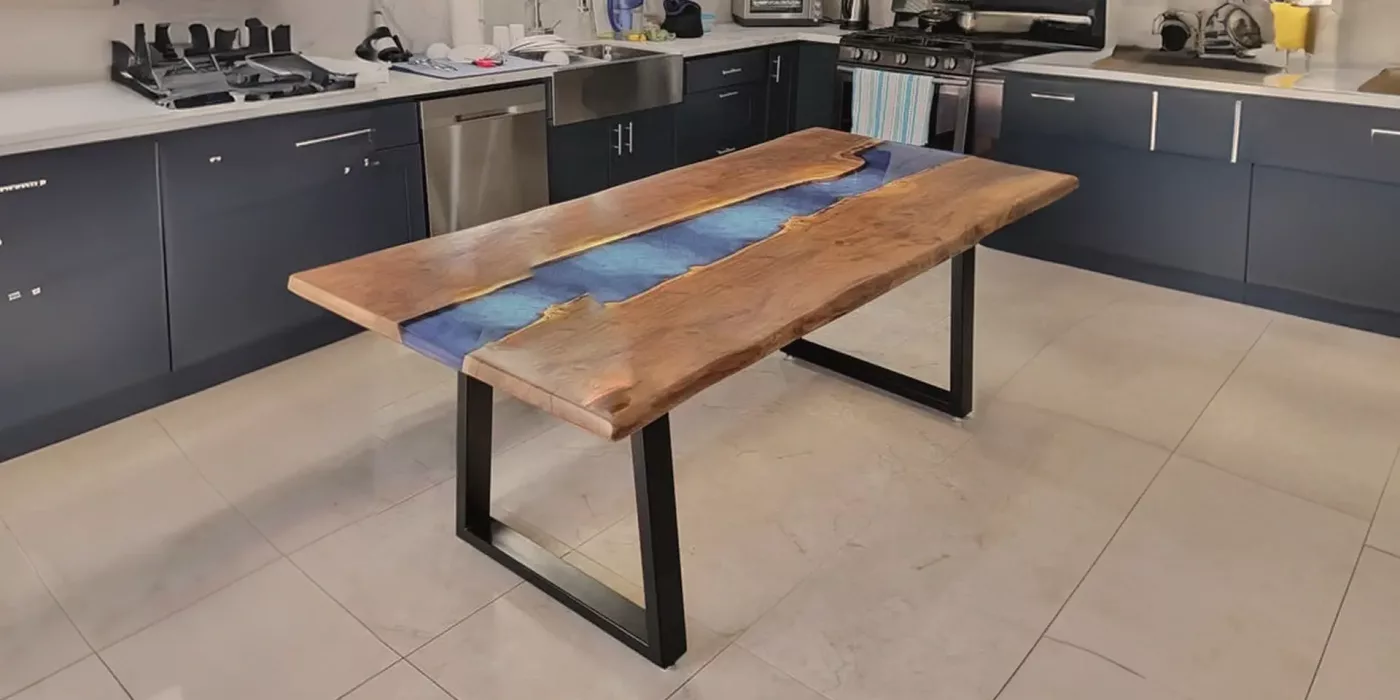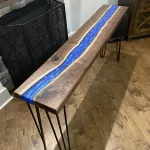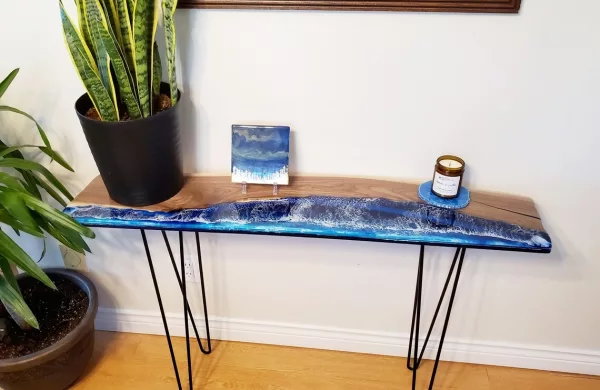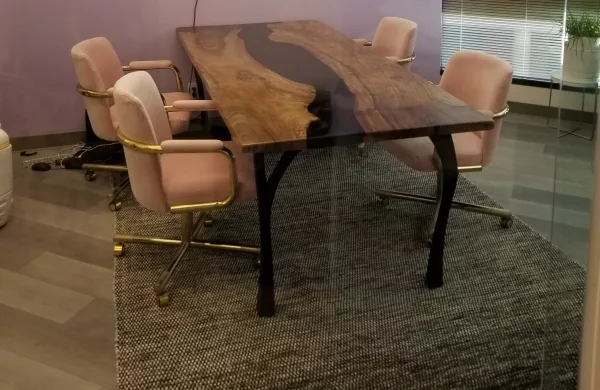
An epoxy table is a piece of furniture, often a table, that incorporates epoxy resin as one of its primary materials. Epoxy resin is a thermosetting polymer that, when mixed with a hardener, undergoes a chemical reaction leading to a hard, durable finish. This material is known for its strength, durability, and aesthetic versatility, making it popular in furniture making, especially for tables. Here are the detailed aspects of epoxy tables:
1. Materials and Composition
Epoxy tables are typically made by combining wood with epoxy resin. The wood used can vary widely, from reclaimed pieces, slabs of hardwood, to softer woods, depending on the desired look and feel. The epoxy resin is then mixed with a hardener and sometimes colorants, glitters, or other decorative elements before being poured into the spaces between the wood or over the entire wood surface to create a smooth, glossy finish.
2. Design and Aesthetic
The versatility of epoxy resin allows for a wide range of designs and aesthetics. These tables can range from simple and elegant, with clear epoxy complementing the natural beauty of the wood, to highly artistic and colorful, incorporating vibrant pigments, metallic powders, or even objects embedded within the resin. The result is often a stunning piece that combines the organic beauty of wood with the modern, sleek appeal of resin.
3. Manufacturing Process
Creating an epoxy table involves several steps. First, the wood is prepared and placed into a mold or frame to define the table’s shape. Then, the epoxy resin is mixed with a hardener (and any desired colorants or additives) and poured over the wood or into the voids between wood pieces. The resin must cure for a period, often several days, under controlled conditions to ensure it hardens correctly. After curing, the table is removed from the mold, and further finishing touches, such as sanding and polishing, are applied to achieve a smooth surface.
4. Durability and Maintenance
Epoxy tables are prized for their durability. The resin surface is water-resistant, scratch-resistant, and able to withstand most daily wear and tear, making it suitable for both home and commercial environments. Maintenance typically involves regular cleaning with non-abrasive materials and occasional polishing to maintain its shine. However, it’s important to avoid placing hot items directly on the surface, as extreme heat can damage the resin.
5. Applications
Epoxy tables are used in various settings, from dining rooms and kitchens to offices and galleries. Their unique blend of natural and synthetic materials can complement a wide range of interior designs, from rustic to ultra-modern. Additionally, because each piece of wood and each epoxy pour is unique, each table is one-of-a-kind.
6. Environmental Considerations
While epoxy tables can be eco-friendly, especially when made with reclaimed wood, the environmental impact of epoxy resin itself is a consideration. It’s derived from petrochemicals, and its production and disposal require careful handling to minimize harmful effects on the environment. However, the durability of epoxy furniture means it can last many years, reducing the need for frequent replacements.
How much does it cost to epoxy a table?
The cost of epoxying a table can vary widely based on several factors, including the size of the table, the type and quality of materials used (both wood and epoxy resin), the complexity of the design, and whether you are doing it yourself or hiring a professional. Here’s a breakdown of these factors to give you a better understanding:
1. Material Costs
- Epoxy Resin: The amount of resin needed depends on the table size and the design’s complexity. Resin costs can range from $50 to $100 or more per gallon. Larger tables or designs that require thicker layers of resin will need more gallons, increasing the cost.
- Wood: The wood cost will depend on the type, quality, and size. A live edge slab for a dining table, for example, can range from a few hundred dollars to several thousand, depending on the wood species and size.
- Additional Materials: Costs for molds, colorants, metallic powders, and any other decorative elements need to be considered. Also, tools and equipment for mixing and applying the epoxy can add to the cost if you don’t already have them.
2. Labor Costs
If you choose to hire a professional to make your epoxy table, labor costs can significantly affect the total price. The expertise, reputation of the craftsman, and geographic location will influence these costs. Professional work can range from a few hundred to several thousand dollars on top of the material costs.
3. DIY vs. Professional
- DIY: If you’re making the table yourself, you’ll save on labor costs but will need to invest in materials and possibly tools. A DIY epoxy table project could cost anywhere from a couple of hundred dollars to over a thousand, primarily depending on the size of the table and the materials used.
- Professional: Commissioning a table from a professional can range widely in price, from around $500 to $5000 or more. The advantage of professional work is the expertise and quality of the finished product.
4. Complexity and Design
A table with a simple design and minimal epoxy might be on the lower end of the cost spectrum, while a large table with intricate designs, colors, and features like embedded objects will be on the higher end.
Pros & Cons of Epoxy Table
Epoxy tables are unique furniture pieces celebrated for their beauty and durability, but they come with their own set of advantages and challenges. Here’s an exploration of the pros and cons of epoxy tables and strategies for managing the downsides:
Pros
- Durability and Resistance: Epoxy resin is highly durable, water-resistant, and able to withstand scratches and impacts better than many natural wood surfaces. This makes epoxy tables a long-lasting choice for both homes and commercial spaces.
- Customization and Aesthetics: The versatility of epoxy resin allows for endless customization options. Colors, patterns, and objects can be embedded into the resin, creating unique and visually striking pieces that can fit any interior design.
- Seamless Surfaces: Epoxy creates a smooth, seamless surface that can cover the entire table or be used to fill in gaps and cracks in wood, preserving its natural beauty while enhancing its durability.
- Maintenance: Epoxy tables are relatively easy to clean and maintain. Their non-porous surface means spills can be wiped up without staining.
Cons
- Cost: High-quality epoxy resin and the craftsmanship required to create a beautiful table can be expensive. The material cost, labor, and time needed to design, pour, and cure the resin contribute to the overall cost.
- Weight: Epoxy tables, especially large ones, can be quite heavy, making them difficult to move or transport.
- Sensitivity to Heat and UV Light: While epoxy is durable, it can be sensitive to extreme heat and UV exposure. Prolonged exposure to sunlight can cause yellowing, and hot items can leave marks or even cause the resin to soften or warp.
- Chemical Sensitivity: Until fully cured, epoxy resin can emit fumes that are harmful to inhale. Additionally, some individuals may have sensitivities or allergic reactions to the chemicals in epoxy.
Handling the Cons
- Cost Management: To manage costs, consider a DIY approach if you’re skilled enough, or choose a simpler design that requires less resin and labor. Researching and sourcing materials economically can also help.
- Weight Considerations: Plan the placement of your epoxy table carefully to avoid the need to move it frequently. Ensure the base and flooring can support the weight.
- Protecting from Heat and UV: Use coasters or mats to protect the surface from hot items. For tables exposed to sunlight, consider epoxy formulations with UV inhibitors to reduce yellowing. Using a UV-resistant topcoat can also offer additional protection.
- Safety Precautions: When working with epoxy, always work in a well-ventilated area, use protective gear like gloves and masks, and follow the manufacturer’s safety guidelines. Choose epoxy products with lower VOC (volatile organic compounds) levels to minimize fumes.
- Repair and Maintenance: For scratches or damage, epoxy tables can often be repaired by sanding the affected area and applying a new layer of resin. Regular cleaning with mild soap and water, and avoiding abrasive cleaners, will help maintain the table’s appearance.
Epoxy tables blend artistry with functionality, offering unique and durable furniture options. While they come with certain challenges, understanding how to address these cons can enhance their longevity and enjoyment.
Summary
Given these variables, a small DIY epoxy table project could start at a few hundred dollars, while a large, professionally crafted piece with premium materials and a complex design could exceed $5000. The key to determining the cost of epoxying a table is to clearly define the project’s scope, including size, materials, and whether you will do it yourself or hire a professional.








